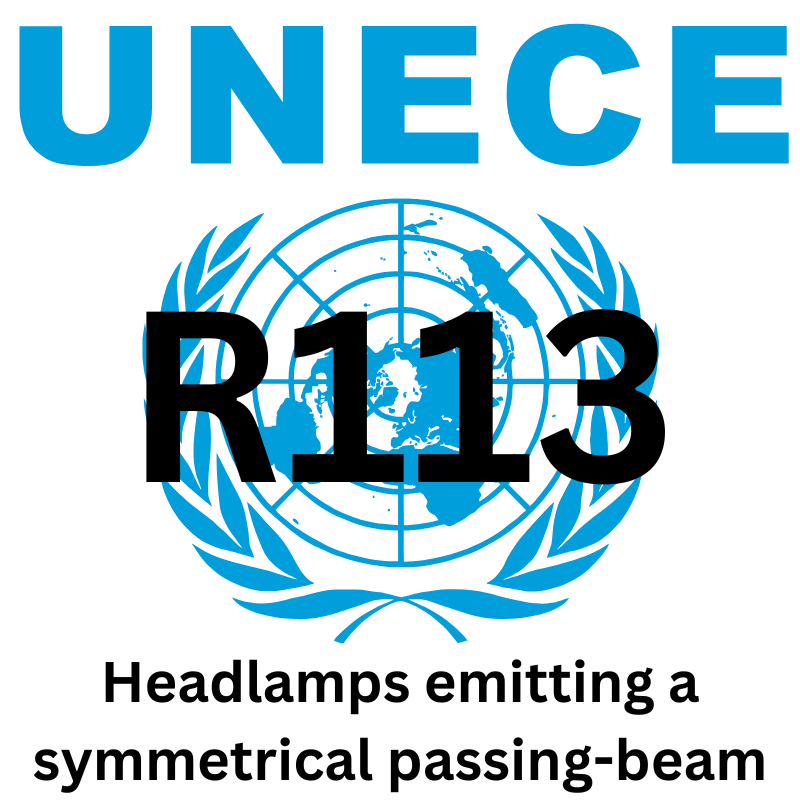Guide To: UNECE R113 - Headlamps emitting a symmetrical passing-beam
23 October 2024

Guide To: UNECE R113 - Headlamps emitting a symmetrical passing-beam
UN ECE Regulation No. 113 establishes uniform provisions concerning the approval of motor vehicle headlamps that emit symmetrical passing-beams or driving-beams, or both. These headlamps, which may be equipped with filament, gas-discharge, or LED light sources, are essential for ensuring proper illumination of the road without causing glare to other road users. The regulation sets out design, safety, and performance standards to enhance road safety.
Scope of the Regulation
UN ECE Regulation No. 113 applies to:
- Headlamps for vehicles in categories L (motorcycles), M (passenger cars), N (goods vehicles), and T (agricultural vehicles).
- Headlamps that are equipped with filament light sources as defined by UN Regulation No. 37, gas-discharge light sources as per UN Regulation No. 99, and LED modules.
Key Features of UN ECE Regulation No. 113
Design and Construction:
- The headlamps must be designed to produce a symmetrical beam pattern, which provides uniform illumination on both sides of the road.
- Headlamps can incorporate filament, gas-discharge, or LED light sources, which are required to meet specific performance criteria, including durability under different environmental conditions.
Photometric and Performance Requirements:
- Headlamps must meet rigorous photometric standards to ensure proper illumination without dazzling other drivers. These standards define the distribution and intensity of light emitted by both the passing and driving beams.
- Plastic lenses used in headlamps must undergo additional tests to ensure they resist degradation from UV radiation.
Marking and Approval:
- Headlamps must carry specific markings, including the manufacturer's name and an approval mark to confirm that they comply with UN ECE Regulation No. 113. These markings ensure traceability and verification of compliance.
Compatibility with Modern Technologies:
- The regulation accommodates LED modules and advanced headlamp systems, such as those offering bend lighting, which provides enhanced illumination when the vehicle is cornering. This ensures that the regulation remains relevant as automotive lighting technologies evolve.
To simplify compliance for manufacturers and ensure a more streamlined regulatory framework, UN ECE Regulation No. 113 has been incorporated into UN ECE Regulation No. 149, which governs road illumination devices. This consolidation integrates the requirements for symmetrical beam headlamps with those of other headlamp technologies, including asymmetrical beam systems and adaptive front-lighting systems (AFS).
The consolidation into Regulation No. 149 offers a unified framework for all road illumination devices, facilitating easier compliance and fostering innovation in lighting technologies such as LED and adaptive systems. This step reflects UNECE’s broader goal of harmonizing vehicle lighting standards, ensuring that manufacturers can achieve international approval with a single, comprehensive regulation.
Conclusion
UN ECE Regulation No. 113 sets the standards for symmetrical beam headlamps, ensuring that they provide safe and effective road illumination. With its incorporation into UN ECE Regulation No. 149, the industry now benefits from a more streamlined regulatory framework for headlamps and other road illumination devices. This consolidation supports the global standardization of vehicle lighting systems, ensuring that they meet stringent international safety requirements while adapting to modern lighting technologies.